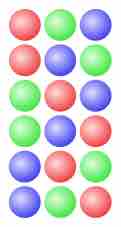Permutations
A permutation of a set of objects is an arrangement of those objects into a particular order. For example, there are six permutations of the set

The 6 permutations of 3 balls
If one has three different colored balls, there are six distinct ways to order them, as shown. These six distinct orderings are as follows: red-green-blue, red-blue-green, green-red-blue, green-blue-red, blue-red-green, and blue-green-red.
The number of permutations of
This is called
In other words, a factorial is to multiply all the numbers from
Example
In the game of Solitaire, seven cards are dealt out at the beginning: one face-up, and the other six face-down. A complete card deck has

One stack of cards in a game of solitaire
To find out how many possible combinations of cards there are below the seven of spades, we use the concept of permutations to calculate the possible arrangements of cards.
How many cards might be in the first position, directly under the showing
If any given card is in the first position, how many cards might be in second position? The answer is
So how many possibilities are there for the first two positions combined? The answer is
How many possibilities are there for all six positions? The answer is
This result can be expressed more concisely by using factorials.
Note that
Consider another example,
General Considerations
In mathematics, the notion of permutation is used with several slightly different meanings, all related to the act of permuting (rearranging) objects or values. Informally, a permutation of a set of objects is an arrangement of those objects into a particular order. The study of permutations generally belongs to the field of combinatorics.
Permutations occur, in more or less prominent ways, in almost every domain of mathematics. They often arise when different orderings on certain finite sets are considered, possibly only because one wants to ignore such orderings and needs to know how many configurations are thus identified. For similar reasons, permutations arise in the study of sorting algorithms in computer science.